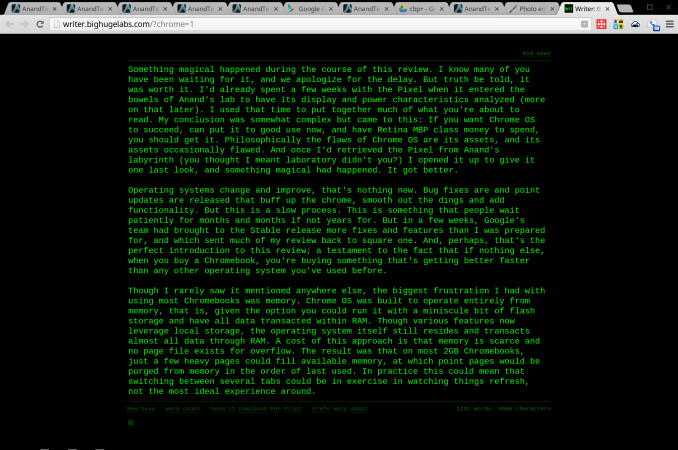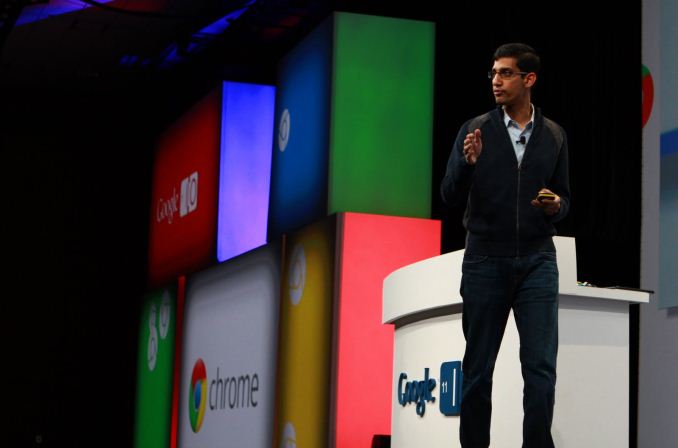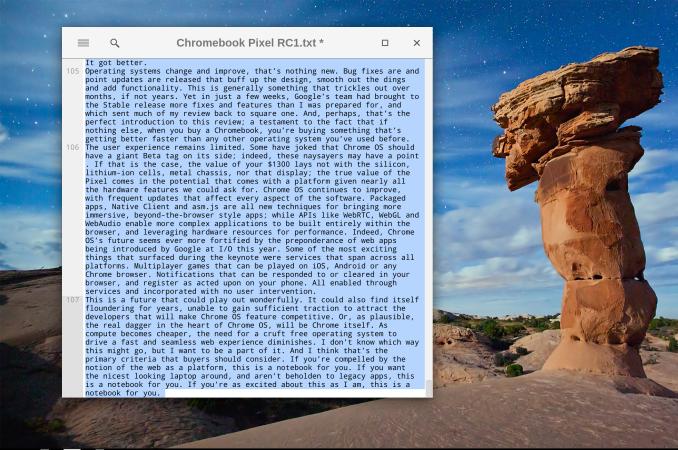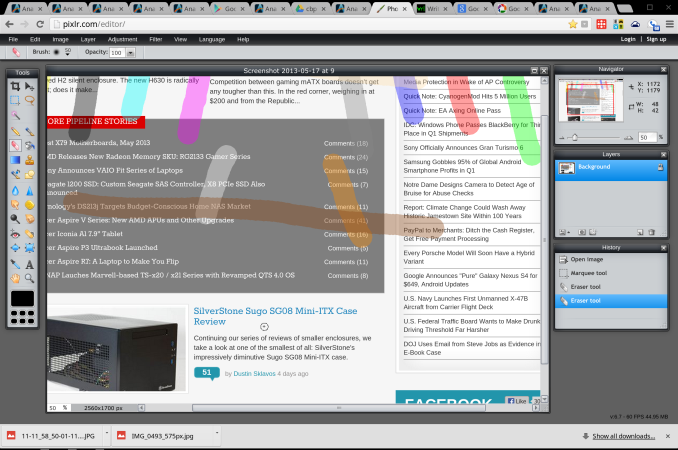Utility
Every time we revisit Chrome OS we ask ourselves “Can we work with it?” As a writing tool, there's no question. The hardware and software limitations of earlier Chromebooks was like slipping blinders on. No distractions, just you and a writing web app. That’s not all you can do with Chrome OS, though; web apps are becoming more powerful and appeal to users because of their ubiquity. Any modern device with a browser can run a web app and offer the same experience no matter the device context. The appeal is currently primarily for developers who don’t have to worry about keeping separate branches of their code updated and optimized on different platforms. As HTML5 and Java progress, the apps built with them will both be more capable, and better able to tap into local resources for compute and data. You could almost imagine a chart that parallels Intel’s “Compute moves to zero” chart, where instead of measuring size, you’re measuring the limitations of browser-based code. So, once anything can happen in a browser, why not live entirely in the browser? Simply put, because we’re not there yet.

Web app Writer, a very minimalist text editor
Why not Android?
The argument goes something like this: Google has a great browser, and a great app platform, they should combine them in a laptop. Thus, the Chromebook should become the Androidbook. It comes up every time a new Chromebook is announced. It’s an idea not entirely without merit. Android runs on ARM and x86 chipsets. It runs Chrome. It has an enormous stable of apps. But that all misses a key fact: laptops aren’t phones or tablets. Chrome OS works because the PC is an utterly different user experience than mobile. And Google believes the conceits of a desktop environment can be best served by just one app: Chrome.

Google SVP Sundar Pichai, introducint Chrome OS at Google I/O 2011
Despite singing this song since the introduction of Chrome OS in 2009, the recent musical chairs at Mountain View has lead many to revive speculation of a future Android/Chrome OS marriage. Andy Rubin, father of Android, is tucked away in some Google skunkworks, and Sundar Pichai caretaker of Chrome OS now manages both experiences. Bringing all of the user facing software divisions under one leader makes sense to me, and not as a harbinger of fusion. During the last 18 months Google has gone through an extensive redesign of all of their assets, trying to bring a unified style and user experience to every product they offer. That experience has been lead by teams in Rubin’s and Pichai’s divisions, along with teams for GMail, Google+ and Search, and all the other products Google offers. But the only division that handles discrete software, and not just services and websites, were Rubin’s and Pichai’s. Bringing those two groups together for closer collaboration makes sense from a design and philosophy standpoint. Merging the very functions of the two into one monolith does not.
Chrome is about the best web experience possible, no matter the platform. Android is about a mobile software and compute experience that relies on apps and integration with Google services to offer utility. Those are two separate directives, the web and apps, and Chrome OS is the purest distillation of the Chrome experience. Shoehorning Android into the Pixel wouldn’t offer the best of both worlds, it would mean forcing a portrait app designed for a phone onto a really nice notebook. If fragmentation remains an issue for Android developers, imagine what happens if you ask them to design their apps to work on phones, tablets, televisions and notebooks. It wouldn’t be pretty.
Utility Continued
For many of us, browsing is about communication and consumption. We watch movies and listen to music in a browser. We chat with friends, send e-mails, engage with our social networks and even partake in video chats and telephony through our browsers. And, of course, we read and peruse images. If we’re going to get work done, though, we need to do more than just communicate and consume, we need to do produce. That means opening an honest to goodness application. Right?
Writing has always been one of Chrome OS’s strong points, and in earlier reviews we mentioned that the limitations of the OS actually helped make this an excellent writer’s tool. It’s hard to not write when all you have is a text field. Plenty of writing apps are just a click away, like the excellent Google Docs, Microsoft’s Office 365 and the minimalist Writer. The advent of Packaged apps is opening the opportunities for more immersive apps that step outside of the browser window. Txt is an early favorite, simple but adaptive, and it isn't stuck in a tab.

<TXT>, a packaged app
Most publishing, web and otherwise, needs more than just text. A few years ago, there was an explosion of excitement around image editing web apps, and everyone and their mother joined the fray, including Adobe and Flickr. Since then, the hype has died down, and the innovation. There are two factors that limit the appeal of these apps. First, there are limitations regarding file size and type. This is mostly owing to bandwidth concerns, both for the user and for the service host. If we had carte blanc to upload all our massive RAW files into an online editor and then edit them and save multiple copies, as we do on our local apps, we would end up with gigabytes of transferred data. So, even on paid apps you’re often limited to a medium sized JPGs, enough for web publishing to be sure, but given that high DPI content has truly arrived this approach is limiting.
The second limitation is in the apps themselves; they’re just not... enough. Several apps take the wizard approach that you might be used to from the likes of Shutterfly. Upload your images and then make modest edits in an interface that’s simplified and easy to navigate. Great for modest work, not so great if you’re planning on doing some serious editing. Want granular control of an image’s rotation? In Lightroom you grab that rotation slider in the Crop tab and adjust it to your comfort; in several image editor web apps, you’re only option is to rotate by 90 degrees at a time. So, yeah, that’s not going to cut it. There are more feature complete apps, but they come at an almost unbelievable cost: Flash. Pixlr is a great example of a web app with a desktop UI, driven by Flash, though the software itself is still limited to JPGs. So, for now, we’re hopeful for the future of photo editing web apps, but it isn't quite there... yet.

Photo editing app Pixlr, driven by Flash
So, you can write, but not do pictures. Video? Not quite yet. Development? That only requires a text editor, right? We thought about a variety of work flows and almost all ended with users putting the included Chrome Remote Desktop to use, to boot up some missing app or function. Even web developers would find themselves hampered by the inability to test IE or Firefox compatibility, and by the limited number of browser based IDEs rolling out. In the end, what we felt comfortable with remained writing and consumption. Those experiences are great, truly, but utility remains a sticking point. It may be time for Google to step-in and start to develop their own advanced productivity tools. Provide a powerful imaging tool and this becomes a powerful web publishing device. Provide the ability to emulate different browsing environments and we might see developers flock to Chromebooks.














74 Comments
View All Comments
8steve8 - Friday, May 31, 2013 - link
I like how you compare it to both laptops and tablets in performance charts, but I'm disappointed that the battery life charts didn't include other laptops.Nimer55 - Saturday, June 1, 2013 - link
I got a chromebook (non-LTE) at I/O, and have been using it instead of my Vizio 14 as my primary machine, and I've gotten the "So it's like an iPad" question a few times, and I've been absolutely clueless as to how this was like an iPad. To me, it appeared to be the opposite of a iPad; you only get websites, where as iOS is all about using an app for everything. Not the mention I get a keyboard to type on. Thank you for clearing that up.Overall, I felt the review was well done; I agree with the 4gb of ram not being enough. I feel performance degrading as I get to few dozen tabs. I really love this laptop, but I would never buy it; it's out of my price range.
The non-tapered edges to make the device appear thicker than it is, but it also makes it feel higher-quality. Having an edge that becomes really thin gives it a "toy-esk" feeling. (My Vizio 14 has it, it makes it feel less premium... Though it's non-aluminum back could be a good cost saving technique if Google were to decide to create one for under a $1000...That and a 1080p-ish resolution would be the most logical cost saving tools to me. Those and a cheaper, but next-gen CPU would be way of getting the price to around $750).
jabber - Sunday, June 2, 2013 - link
"a few dozen tabs".....Wow...what exactly are you doing that requires 24+ browser tabs open?
I have the Samsung 11" Chromebook and use it a lot but usually sits around half a dozen open max.
Selden - Saturday, June 1, 2013 - link
Excellent review, as I expect from Anandtech. I agree with you fully about memory management, which is an Achilles heel for Chrome OS. ZRAM definitely helps, but the file manager, even on the latest beta (Version 28.0.1500.20), is an utter pig. I'm on an extended trip to Alaska, taking a lot of photos, and copying, let alone viewing/editing photos quickly runs free memory down below 100 mb. Pushed hard enough, the image viewer will start behaving erratically; the only option then is to restart — fortunately, a rapid process, but it shouldn't be necessary.leexgx - Saturday, June 1, 2013 - link
for the price of the new chromebook 8gb of ram should be very easynerdstalker - Saturday, June 1, 2013 - link
For a device that promises mostly web browsing and integration with the cloud services, WiFi performance of Pixel is not stellar. It has 2x2 MIMO (2 dual band antennas) that is comparable to Macbook Air. However, WiFi performance is not as good as MBA, especially 5 GHz. rMBP models on the other hand (both 13" and 15") have top notch 3x3 MIMO (3 dual band antennas) with pretty good throughputs.internetf1fan - Saturday, June 1, 2013 - link
Few things about your review.#1) Why did you use sunspider 0.9.1 when V1 was just recently released?
#2) Since you are comparing hardware, it would be best to use the same software where possible. Chrome OS the chrome browser, so instead of using stock browser on other OS, you should have installed chrome on Mac and Surface Pro as well so that the hardware comparison would be consistend.
leexgx - Saturday, June 1, 2013 - link
all other tests was done with 0.9.1at least test stock and chrome on sunspider
ECIT - Monday, June 3, 2013 - link
I must admit that I was a bit sceptical when the Pixel was announced. Google has enough work convincing people to buy into the whole Chromebook concept even with low-cost versions, let alone at Pixel's price.On the other hand, the Pixel does look pretty cool. And I do think that Chromebooks in general have their place in the market, especially as a second home device. Most people spend a lot of their time on the Internet anyway, and there are more and more web apps out there.
For those that are considering Chromebooks but still need to access Windows applications, they can look at Ericom AccessNow, an HTML5 RDP client that enables Chromebook users to connect to Terminal Server or VDI virtual desktops, and run Windows applications or even full desktops in a browser tab.
Click here for more information:
http://www.ericom.com/RDPChromebook.asp?URL_ID=708
Please note that I work for Ericom
jeffkro - Monday, June 3, 2013 - link
Wow, way to expensive and an overkill display for the screen size. I would like to see a 14-15" 1080p chromebook in the $500-600 range, no laptops should have less than 1080p these days. Also since chrome OS is so lightweight you really only need a 1.5ghz celeron processor.